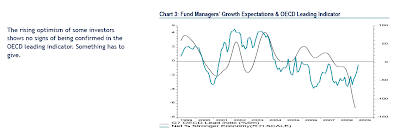China fuels sharp bounce in growth expectations
A jump in optimism on the Chinese economy (growth expectations leaped from -70% to -21%) and further policy ease led to a marked improvement in global economic sentiment. While 90% of investors think we are currently in a global recession only a net 6% see a weaker economy in the next 12 months (versus 24% last month and 60% in October). February's optimism must now be corroborated by global lead indicators in coming months to avoid investor disappointment.
Commodity allocation up; equities & bonds down
Growth optimism did not translate into higher equity allocations however: a net 34% are underweight, back to December levels. Commodities were the beneficiary with the net overweight position (-15%) rising to its highest level in six months (note gold now seen as overvalued). Unsurprisingly after a tough January, bond overweights were trimmed.
A timid recovery in risk appetite
Cash balances were trimmed to 4.9% (from 5.3%); both investors and allocators reduced cash overweights. Having troughed at 25 back in October, our Risk & Liquidity Composite Indicator improved to 31 but remains well below the average
score of 40. The timid recovery in risk appetite is corroborated by sustained investor pessimism on bank stocks.
Regional & sector rotation shows tentative cyclical shift
US still seen as favorite developed equity market; China still favored emerging market. Asset allocators heavily reduced positions in Japan and remain UW (underweight) Europe, neutral GEM. Sector allocation reveals tentative pro-cyclical shift: big overweights in telco, staples were trimmed and recycled into tech, energy, materials, industrials & discretionary. But banks remain by far and away the least favored global sector. Meanwhile the Japanese yen is the "most overvalued" since 2002 & sterling records its cheapest rating ever.
The most loved and unloved
Most loved: cash, bonds, US, China, telco, pharma, staples. Most unloved: equities, Japan, Europe, banks, industrials, materials. Risk appetite remains structurally low so an extended cyclical rally remains dependent on policy easing, commodity prices and lead indicators maintaining February jump in growth optimism. If these were confirmed, sectors that might benefit would be energy and materials and, given views on currency valuation, this might be best played through Sterling assets.
Hell, this is key in my view: "February's optimism must now be corroborated by global lead indicators in coming months to avoid investor disappointment". Latest weekly ECRI data suggest that "recovery remains elusive".
See also the divergence in the chart (click to enlarge) from the survey, courtesy of Merrill Lynch (this name has better sounding :)) ...

No comments:
Post a Comment